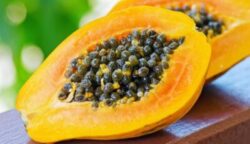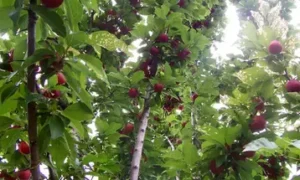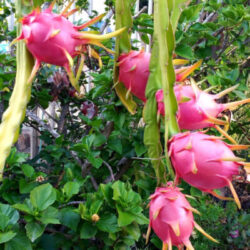
When farmers and gardeners want to raise a certain variety of papaya, knowing the gender of the seeds can be crucial. When it comes to fruit production, male and female papaya trees differ noticeably; female plants yield fruit, while male plants do not. We’ll give a clear explanation of how to distinguish between male and female papaya seeds in this article.
Introduction to Papaya Seeds
Papaya seeds are small, black, and round seeds found in the center of a papaya fruit. They are often overlooked but are actually quite nutritious and have many potential health benefits. In addition, these seeds can also be used for various culinary purposes, such as in smoothies, salads, and even as a substitute for black pepper. However, it’s important to note that there are two types of papaya seeds – male and female – and knowing how to distinguish between them can be crucial for growing papaya trees and utilizing their full potential. In this article, we’ll discuss how to identify male and female papaya seeds and their respective characteristics.
Understanding the Anatomy of a Papaya Seed
To better understand how to identify male and female papaya seeds, it’s important to know the anatomy of a papaya seed. A papaya seed is a small, oval-shaped seed that measures about 2-3mm in diameter. It has a hard outer shell, which is brown or black in color, and a thin, white inner layer. The outer layer of the seed is called the seed coat or testa, which protects the embryo inside. The inner layer is called the endosperm, which provides nutrients to the embryo during germination. The embryo itself is the tiny plant that grows from the seed when it’s planted in soil. Understanding the anatomy of a papaya seed can help you identify whether it’s male or female.
Also Read: All You should know about Panama Berries
Differences Between Male and Female Papaya Trees
Male and female papaya trees have some distinct differences that can help you identify their seeds. Here are some key differences between male and female papaya trees:
- Flowers: The flowers of a male papaya tree are smaller and have long, thin stalks. They typically grow in clusters along the tree’s trunk and branches. In contrast, the flowers of a female papaya tree are larger and have short, thick stalks. They grow at the top of the tree and typically produce fruit.
- Fruit: Male papaya trees do not produce fruit. In contrast, female papaya trees produce fruit that can vary in size, shape, and color depending on the variety.
- Leaf shape: The leaves of male papaya trees are smaller and narrower compared to the leaves of female papaya trees, which are larger and more rounded.
- Growth rate: Female papaya trees typically grow slower than male papaya trees. In addition, female papaya trees require more nutrients to produce fruit and may need additional fertilization.
Knowing these differences can help you identify whether a papaya tree is male or female and in turn help you determine the type of seeds it produces.
Characteristics of Male Papaya Seeds
Male papaya seeds have a few distinct characteristics that set them apart from female papaya seeds. Here are some key characteristics of male papaya seeds:
- Size: Male papaya seeds are generally smaller than female papaya seeds.
- Shape: Male papaya seeds are typically more round or oval in shape compared to female papaya seeds, which may have a more oblong or elongated shape.
- Color: Male papaya seeds are usually darker in color, ranging from dark brown to black.
- Texture: The outer layer of male papaya seeds is usually smoother and more uniform in texture than female papaya seeds.
- Viability: Male papaya seeds are not viable for growing papaya trees. They do not contain the genetic material necessary to produce female flowers or fruit.
It’s important to note that while male papaya seeds cannot be used to grow papaya trees, they can still be used for culinary purposes and have potential health benefits.
Characteristics of Female Papaya Seeds
Female papaya seeds also have a few characteristics that set them apart from male papaya seeds. Here are some key characteristics of female papaya seeds:
- Size: Female papaya seeds are generally larger than male papaya seeds.
- Shape: Female papaya seeds may have an oblong or elongated shape, with a slight curve.
- Color: Female papaya seeds are typically lighter in color, ranging from light brown to a pale cream color.
- Texture: The outer layer of female papaya seeds is usually rougher and more irregular in texture compared to male papaya seeds.
- Viability: Female papaya seeds are viable for growing papaya trees. When planted in soil, they have the potential to produce a female papaya tree that will produce fruit.
It’s important to note that while female papaya seeds have the potential to grow into a fruit-bearing tree, not all seeds will germinate successfully. The viability of the seed depends on several factors, including the age of the seed, its quality, and the conditions in which it’s planted.
Also Read: How to make a Trellis for blackberries
How to Identify a Male and Female Papaya Seeds
Identifying male and female papaya seeds can be a bit challenging, but here are a few tips that can help:
- Look for seeds inside ripe papaya fruit: The easiest way to identify papaya seeds is to cut open a ripe papaya fruit and look for the small, round seeds inside. Make sure the fruit is fully ripe, as unripe fruit may not have developed seeds yet.
- Observe the shape of the seed: Female papaya seeds tend to be longer and more oblong in shape compared to male papaya seeds, which are more round or oval-shaped.
- Check the color of the seed: Male papaya seeds are usually darker in color, ranging from dark brown to black. Female papaya seeds, on the other hand, are usually lighter in color, ranging from light brown to a pale cream color.
- Check the texture of the seed: The outer layer of male papaya seeds is usually smoother and more uniform in texture than female papaya seeds, which tend to be rougher and more irregular.
- Consider the source of the seed: If you’re trying to identify seeds without the context of the fruit, it may be helpful to consider the source of the seed. If the seed came from a tree that produces fruit, it’s more likely to be a female seed. If it came from a tree that doesn’t produce fruit, it’s more likely to be a male seed.
By using these tips, you can improve your ability to distinguish between male and female papaya seeds.
Importance of Identifying Male and Female Papaya Seeds
Identifying male and female papaya seeds is important for a few reasons:
- Fruit production: Papaya fruit is an important agricultural crop, and farmers need to know which trees are male and which are female to optimize fruit production. Only female trees produce fruit, so it’s important to identify and cultivate them for commercial purposes.
- Breeding: If you’re interested in breeding papaya trees, you’ll need to identify male and female trees to ensure successful cross-pollination. This can help you create new varieties of papaya with desirable traits, such as improved disease resistance or higher yields.
- Culinary use: Papaya seeds have culinary uses, and some people use them in smoothies, salads, or as a substitute for black pepper. Knowing the difference between male and female papaya seeds can help you choose the right seeds for your culinary needs.
- Medicinal use: Papaya seeds also have potential health benefits, including antimicrobial and anti-inflammatory properties. Research has shown that consuming papaya seeds may help with digestive issues, such as constipation or bloating. Identifying the seeds correctly can help you use the right seeds for medicinal purposes.
In summary, identifying male and female papaya seeds is important for fruit production, breeding, culinary and medicinal uses. By understanding the differences between the seeds, you can make informed decisions about how to use them.
Also Read: Are kiwi Fruits Acidic or Alkaline
Conclusion and Final Thoughts
In conclusion, identifying male and female papaya seeds is important for growers, breeders, chefs, and anyone interested in using papaya seeds for culinary or medicinal purposes. While it can be a bit challenging to distinguish between male and female seeds, there are several characteristics you can look for, including size, shape, color, and texture. By using these tips, you can better understand the anatomy of papaya seeds and how to use them effectively. Whether you’re growing papaya trees for commercial purposes, experimenting with new recipes, or exploring the potential health benefits of papaya seeds, identifying the seeds correctly is a crucial first step.
Frequently Asked Questions And Answers
Here are some frequently asked questions about identifying male and female papaya seeds:
Can you tell if a papaya seed is male or female just by looking at it?
It can be difficult to tell the sex of a papaya seed just by looking at it, but there are a few characteristics that can help you make an educated guess. For example, female seeds tend to be larger and more elongated in shape, while male seeds are usually smaller and more round in shape.
Are male papaya seeds completely useless?
While male papaya seeds cannot produce fruit, they can still be useful for some purposes. For example, they can be used to make papaya seed oil, which is used in cosmetics and skincare products.
How do you know if a papaya seed is viable?
The viability of a papaya seed depends on several factors, including its age, quality, and the conditions in which it’s planted. To determine if a seed is viable, you can perform a germination test by planting the seed in soil and monitoring its growth over time.
Can you eat papaya seeds?
Papaya seeds are edible and have a slightly peppery flavor. They can be eaten raw, roasted, or ground into a powder and used as a spice. However, they should be consumed in moderation, as large quantities can be toxic.
How do you store papaya seeds?
To store papaya seeds, first remove them from the fruit and wash them thoroughly. Then, spread them out on a clean towel to dry. Once they’re completely dry, store them in an airtight container in a cool, dry place. Stored properly, papaya seeds can remain viable for up to 3 years.







